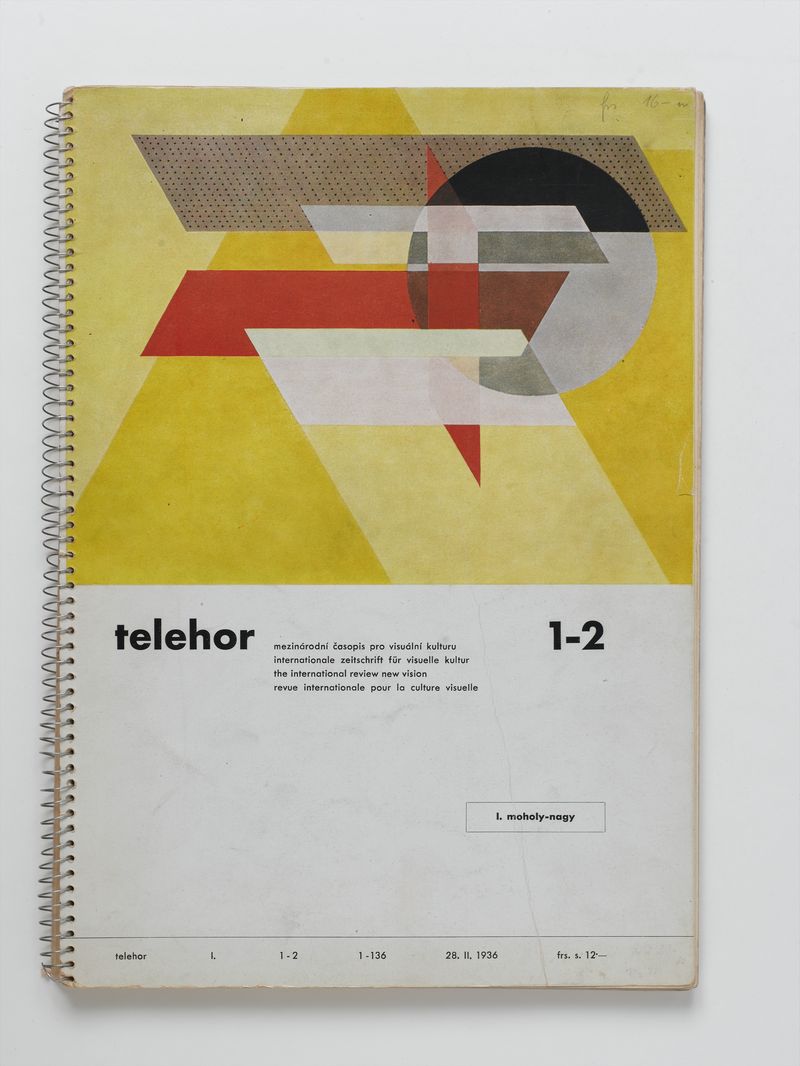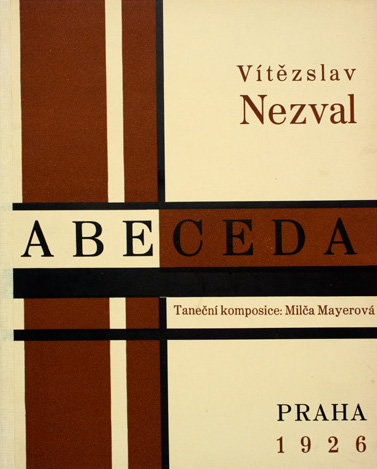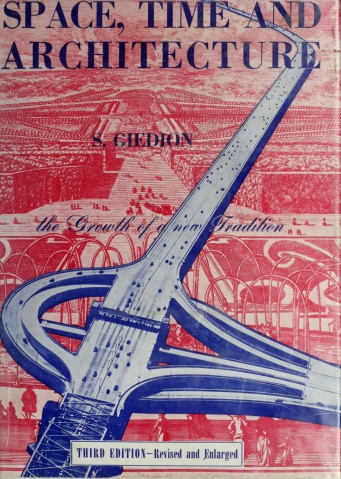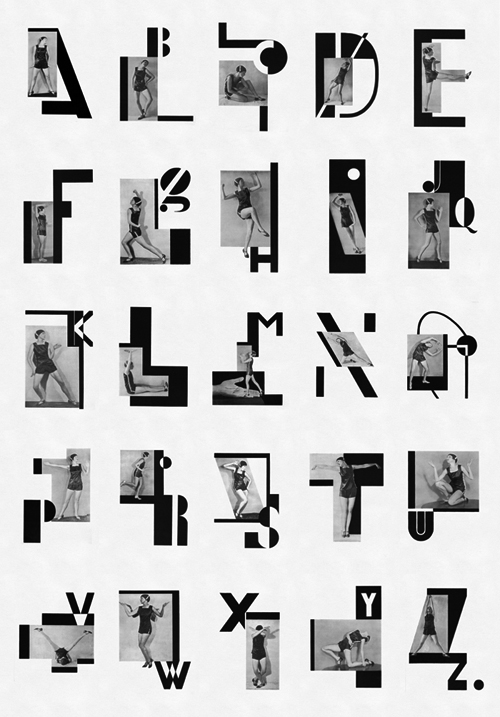Fr. Kalivoda (ed.): Telehor 1-2: Special Issue on L. Moholy-Nagy (1936) [CZ/DE/EN/FR]
Filed under magazine | Tags: · art, avant-garde, colour, design, film, light, photography, vision

Telehor was a project by Czech functionalist architect, theorist and educator, František Kalivoda, who planned it as a 64-page illustrated quarterly dedicated to visual culture. As an editor and publisher, Kalivoda had established an impressive network of collaborators across Europe, however his plans never fully took off.
Its only issue appeared as a book-length publication on the work of artist and Bauhaus teacher László Moholy-Nagy who was at the time already living in London. The magazine has, in the internationalist fashion, sections in several languages, including French, English, Czech, and German.
Contents of the English section: Foreword by Siegfried Giedion, 1935 (pp 27-29), Letter from Moholy-Nagy to Kalivoda, June 1934 (30-32), Moholy-Nagy’s essays “From Pigment to Light”, 1923-26 (32-34), “A New Instrument of Vision”, 1932 (34-36), “Problems of the Modern Film”, 1928-30 (37-40), “Supplementary Remarks on the Sound and Colour Film”, 1935 (41-42), “Once a Chicken, Always a Chicken”, a film script on a motif from Kurt Schwitter’s “Auguste Bolte”, 1925-30 (43-45), Postscript by Kalivoda, 1936 (45-46).
The reproductions run from page 49 through 112.
Publisher Fr. Kalivoda, Brno, 1936
Typography Fr. Kalivoda
Print Typia Press, Brno
138 pages, 69 ills., 29.7 × 21 cm
via Bibliothèque Kandinsky, in the Unlimited Edition
Moholy-Nagy at Monoskop wiki
Kalivoda at Monoskop wiki
PDF, PDF (variant with black cover, 149 MB)
Comment (1)Vítězslav Nezval: Abeceda (1926)
Filed under artist publishing, poetry | Tags: · alphabet, avant-garde, dance, photography, poetry, typography

“In Nezval’s Abeceda, a cycle of rhymes based on the shapes of letters, I tried to create a ‘typofoto’ of a purely abstract and poetic nature, setting into graphic poetry what Nezval set into verbal poetry in his verse, both being poems evoking the magic signs of the alphabet.” – Karel Teige
The 1926 book Abeceda [Alphabet] is a landmark work of the artists’ collective Devětsil, active in Prague and Brno in the 1920s.
“The composition of Abeceda took place in three stages. Vítězslav Nezval wrote the poem in 1922 along the line of the grade-school syllabary, matching each letter of the alphabet with a single rhyming quatrain. Nearly every verse takes its lead from the visual aspect of its letter and proceeds as a sequence of fanciful associations: “A / let us call you a simple hut / Transport your tropics to the Moldau, o palms / A snail has its simple home with feelers sticking up / while people don’t know where to lay their heads.” For a celebratory Nezval evening in 1926 at the Liberated Theater in Prague, Milča Mayerová contributed a choreographed alphabet that complemented each quatrain with a sequence of poses. The composition concluded with Karel Teige’s addition of photo-montages that join photographs of Mayerová’s embodied alphabet with his own geometric letterforms.
Nezval’s verses follow from his conviction that poetry, as a game of language played at the level of its rudiments, provided a means of transforming the world directly. The photos of Mayerová illustrate in concrete terms this intimacy between language and reality; the poses have her almost trying the alphabet on for size. Teige’s photomontages organize that alphabetized figure with geometric letters according to the structure of the grid, which the artist regarded as an emblem of rational order. In setting Mayerová’s figure in gridded relation to the alphabet, Teige seemed to be insisting that readers consider the realities of life in relation to letters whose shapes they not only determine, but that in turn determine them.” (Source)
Abeceda. Taneční komposice Milči Mayerové
Publisher J. Otto, Prague, 1926
Illustrated with 25 black and white photomontages
57 pages
via V&A
Video adaptation (8 min, 2000, made at the Wolfsonian-FIU, Miami)
PDF (with Nezval’s poems in Czech, low resolution)
PDF (images only, low resolution)
Sigfried Giedion: Space, Time and Architecture (1941–)
Filed under book | Tags: · architecture, city, history of architecture, urbanism

“A milestone in modern thought, Space, Time and Architecture has been reissued many times since its first publication in 1941 and translated into half a dozen languages. It is a pioneering and influential standard history giving in integrated synthesis the background and cultural context of modern architecture and urban planning, set in their manifold cultural relationships “with other human activities and the similarity of methods that are in use today in architecture, construction, painting, city planning and science.”
The book had its genesis in the Charles Eliot Norton Lectures at Harvard University in the spring of 1938, and it was recognized from the outset as a series of related essays on seminal topics in the organization of human spaces, obtaining fresh insights, not from a panoramic survey, “but by isolating and examining certain specific events intensively, penetrating and exploring them in the manner of the close-up” as Giedion outlined his method.” (Wikipedia)
First published in 1941
Third edition, enlarged, 1954
Fifth edition, revised and enlarged, 2009
Publisher Harvard University Press, Cambridge, MA
778 pages (3rd ed.)
Reviews: Ben Ray Redman (The Saturday Review, 1954), Arthur P. Molella (Technology and Culture, 2002), Sarah Bay Williams (The Art Book Review, 2013).
Publisher (5th ed.)
PDF (3rd ed., 173 MB, updated on 2017-1-2)
PDF (5th ed., 429 MB, added on 2021-7-12)


